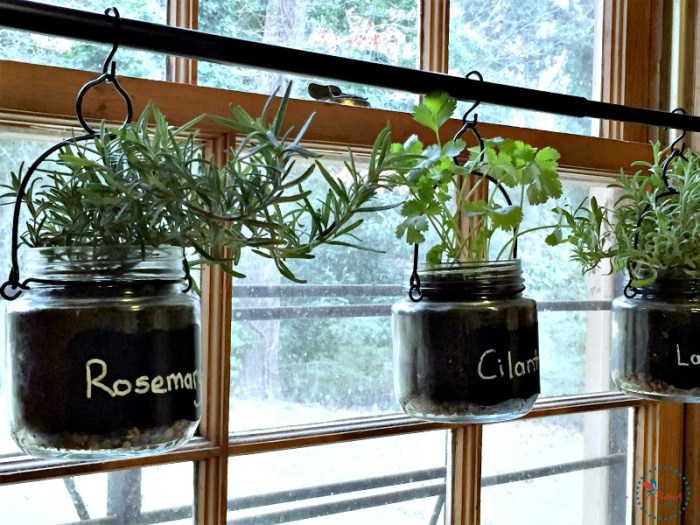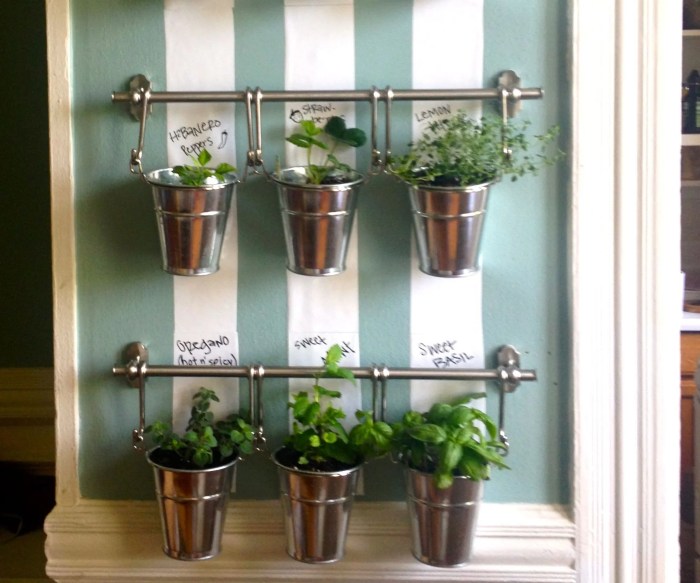Discover the art of vertical gardening with 7 DIY hanging herb garden indoor ideas. Optimize space, enhance aesthetics, and bring fresh herbs to your fingertips with these innovative designs.
Whether you’re a seasoned gardener or a novice, this guide provides step-by-step instructions, design inspiration, and essential tips for creating a thriving indoor herb garden.
Vertical Herb Garden Design
Vertical gardening offers a plethora of advantages for herb cultivation. It maximizes space utilization, particularly in compact indoor environments. By suspending herbs vertically, you can create a lush green tapestry that enhances the ambiance of your living space while providing fresh, flavorful herbs within arm’s reach.
Design Considerations
When designing a hanging vertical herb garden, consider the following factors:
- Space optimization:Vertical structures allow you to grow multiple herbs in a limited footprint. Utilize tiered shelves, hanging planters, or trellises to maximize vertical space.
- Aesthetics:Choose materials and designs that complement your home decor. Natural materials like wood or bamboo exude a rustic charm, while metal or plastic structures offer a modern aesthetic.
- Materials and techniques:Select sturdy materials that can withstand the weight of plants and soil. Use hooks, brackets, or chains to securely suspend the structure from the ceiling or walls.
Herb Selection and Placement

Creating a thriving indoor hanging herb garden requires careful consideration of herb selection and placement. Understanding the light requirements, growth habits, and companionability of different herbs is crucial for optimal growth.
Indulge in the aromatic wonders of a 7 DIY hanging herb garden indoor, where fresh herbs thrive within arm’s reach. Explore Different Types of Indoor Hanging Plants: Beautify Your Home with Nature’ to discover a symphony of greenery, from cascading ferns to vibrant succulents.
Embrace the beauty and practicality of indoor hanging plants, and elevate your home with a touch of nature’s charm.
Proper spacing and arrangement within the hanging containers are equally important. Adequate space allows for proper air circulation, preventing disease and promoting healthy growth.
Herb Selection
- Light Requirements:Consider the amount of natural or artificial light available in your growing space. Herbs like basil, oregano, and rosemary prefer bright, indirect light, while mint and parsley tolerate lower light conditions.
- Growth Habits:Some herbs, such as basil and oregano, have a bushier growth habit and may require more space. Herbs with a trailing habit, like thyme and rosemary, can be grown in hanging baskets or vertical arrangements.
- Companionability:Certain herbs, such as basil and tomato, complement each other when grown together. Avoid planting herbs that have conflicting needs or may inhibit each other’s growth.
Container and Soil Selection
Choose hanging containers with adequate drainage holes to prevent waterlogging. Terracotta or plastic containers are suitable options. The soil should be well-draining and rich in organic matter. A mixture of potting soil, compost, and perlite provides a suitable growing medium.
7 DIY hanging herb garden indoor ideas offer a practical and aesthetically pleasing way to grow fresh herbs indoors. For those interested in creating their own hanging plant displays, Hanging Plants provides a comprehensive guide to selecting the right plants, choosing suitable containers, and creating beautiful hanging arrangements.
Whether you’re a seasoned gardener or a beginner looking to bring greenery into your home, these 7 DIY hanging herb garden indoor projects provide inspiration and guidance for creating a thriving indoor herb garden.
Lighting and Watering

Ensuring optimal lighting and proper watering is crucial for the success of indoor hanging herb gardens. Adequate light exposure promotes healthy plant growth, while appropriate watering techniques prevent over- or under-watering.
Lighting Requirements
Most herbs require at least 6 hours of sunlight per day. If natural light is limited, supplemental lighting can be provided using grow lights. Choose LED grow lights with a spectrum that mimics natural sunlight. Place the lights close to the plants to ensure sufficient light exposure.
Watering Techniques
Water hanging herb gardens when the soil feels dry to the touch. Avoid over-watering, as this can lead to root rot. Use a well-draining potting mix to prevent waterlogging. Consider using a moisture meter to monitor soil moisture and adjust watering schedules accordingly.
If you’re looking for a way to add some greenery to your home without taking up too much space, consider creating a DIY hanging herb garden. With just a few simple materials, you can create a beautiful and functional herb garden that will add a touch of freshness to your kitchen or living room.
For more inspiration on how to incorporate hanging plants into your indoor decor, check out Decorative Hanging Planters for Indoor Spaces: Enhance Your Home with Greenery . With a little creativity, you can easily create a DIY hanging herb garden that will add both beauty and functionality to your home.
Harvesting and Maintenance
Harvesting and maintaining hanging herb gardens requires attention to detail and regular care. Understanding the optimal time and techniques for harvesting, along with proper pruning, fertilizing, and pest control practices, ensures a thriving and productive herb garden.
Harvesting
Harvesting herbs from hanging gardens should be done regularly to encourage new growth and prevent bitterness. The best time to harvest is in the morning after the dew has dried, when the essential oils are most concentrated. Use sharp, clean shears or scissors to cut stems just above a leaf node.
For those looking to create a vertical garden indoors, consider 7 DIY hanging herb garden indoor ideas. These innovative designs not only save space but also add a touch of greenery and freshness to your living area. Whether you’re a seasoned gardener or just starting out, there are options to suit every skill level.
For inspiration and additional guidance, check out Decorative Indoor Plant Hangers: A Guide to Adding Style and Greenery to Your Home , which provides a comprehensive guide to creating stylish and functional indoor plant displays. With a little creativity and effort, you can easily transform your home into a vibrant and inviting space with a DIY hanging herb garden indoor.
Avoid over-harvesting, taking only a third of the plant at a time to maintain its health and appearance.
Maintenance
Regular maintenance tasks are essential for the health and productivity of hanging herb gardens. Pruning involves removing dead or damaged leaves and stems, as well as pinching back tips of actively growing stems to encourage bushier growth. Fertilizing every few weeks with a balanced liquid fertilizer provides nutrients for healthy growth.
Pest control measures include regular inspection for pests and diseases, and timely application of organic or chemical treatments if necessary.
Preservation and Storage, 7 diy hanging herb garden indoor
To preserve and store harvested herbs, various methods can be used. Drying is a common technique, where herbs are hung upside down in a warm, well-ventilated area until completely dry. Alternatively, freezing herbs in airtight containers preserves their flavor and nutrients for several months.
Herbs can also be stored in olive oil or vinegar for use as infused oils or vinegars.
Aesthetics and Display
Hanging herb gardens can elevate the visual appeal of your home while providing fresh herbs within reach. Incorporating them into your décor adds a touch of greenery and creates a unique ambiance.
Consider using decorative containers to house your herbs. Terracotta pots, rustic wooden crates, or hanging baskets can add charm and complement various décor styles. Trellises provide support for climbing herbs like rosemary and thyme, creating a vertical garden effect.
Display Ideas
- Kitchen:Hang herb gardens near the stove or cooking area for easy access while cooking.
- Living Room:Add a touch of greenery to your living space by displaying hanging herbs in a sunny window or corner.
- Outdoor Spaces:Create a charming outdoor oasis by hanging herb gardens on a patio, balcony, or porch.
Summary: 7 Diy Hanging Herb Garden Indoor
Embrace the convenience and beauty of hanging herb gardens, transforming your home into a culinary haven. Experiment with different designs, select the right herbs, and enjoy the benefits of fresh, homegrown ingredients at your fingertips.
Frequently Asked Questions
How often should I water my hanging herb garden?
Water when the soil feels dry to the touch, typically every 3-5 days.
What are the best herbs to grow in a hanging garden?
Basil, mint, parsley, chives, and thyme are excellent choices for indoor hanging gardens.
How can I prevent pests in my hanging herb garden?
Use organic pest control methods like neem oil or insecticidal soap, and keep the area clean.